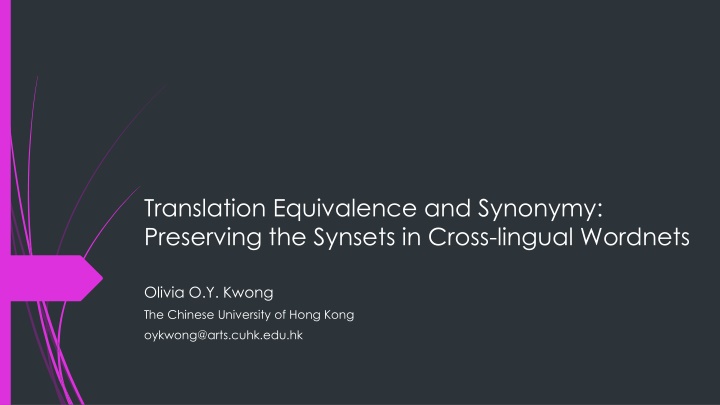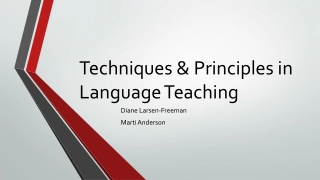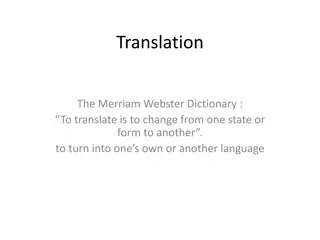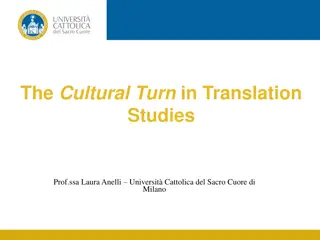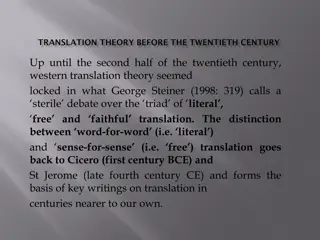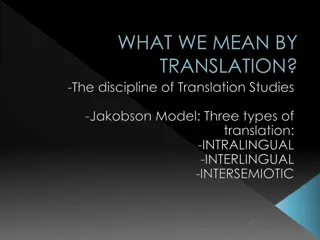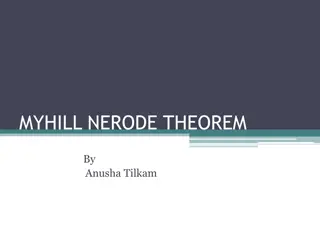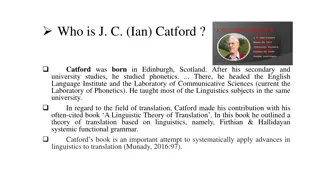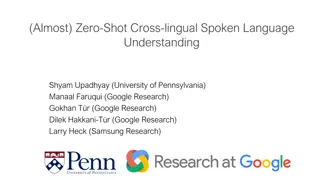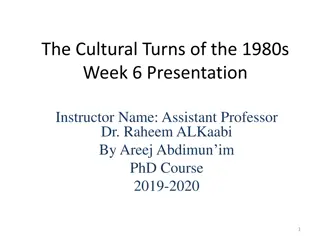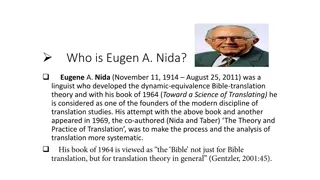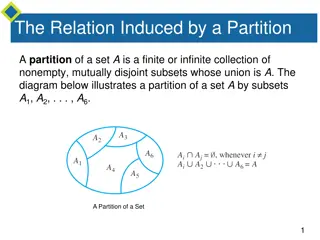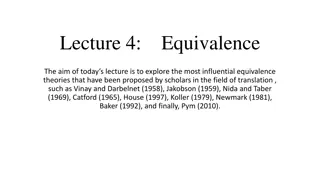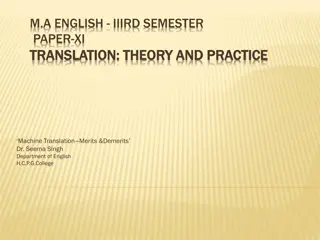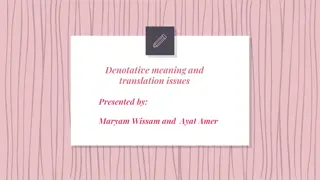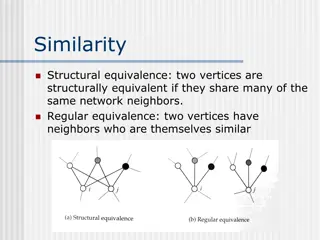Translation Equivalence and Synonymy: Preserving the Synsets in Cross-lingual Wordnets
This study delves into preserving synsets in cross-lingual Wordnets, exploring the infrastructure of Princeton WordNet synsets, and discussing the merge model for Chinese Wordnets. It also highlights potential blind spots in identifying translation equivalents and synonymy. The research touches on various aspects of lexical relationships, emphasizing the importance of accurate equivalence relations for effective cross-lingual communication.
Download Presentation

Please find below an Image/Link to download the presentation.
The content on the website is provided AS IS for your information and personal use only. It may not be sold, licensed, or shared on other websites without obtaining consent from the author.If you encounter any issues during the download, it is possible that the publisher has removed the file from their server.
You are allowed to download the files provided on this website for personal or commercial use, subject to the condition that they are used lawfully. All files are the property of their respective owners.
The content on the website is provided AS IS for your information and personal use only. It may not be sold, licensed, or shared on other websites without obtaining consent from the author.
E N D
Presentation Transcript
Translation Equivalence and Synonymy: Preserving the Synsets in Cross-lingual Wordnets Olivia O.Y. Kwong The Chinese University of Hong Kong oykwong@arts.cuhk.edu.hk
Infrastructure of Princeton WordNet 2 Synsets as building blocks Unordered sets of words that denote the same concept and are interchangeable in many contexts Synonymy / mutual substitutability Nouns, verbs, adjectives, adverbs Adjectives not hierarchically ordered, considered polysemous but of limited use in conveying info 10 Jan 2018 GWC 2018, NTU, Singapore
3 Princeton WordNet Merge Model Expand Model 1. Select vocabulary and develop synsets separately and locally 2. Generate equivalence relations to PWN 1. Start with PWN vocab and synsets 2. Translate synsets into target language using bilingual dictionaries Wordnets in other languages 10 Jan 2018 GWC 2018, NTU, Singapore
Chinese Wordnets 4 Various attempts (Huang et al., 2004; Xu et al., 2008; Huang et al., 2010; Wang and Bond, 2013) (Semi-)automatic identification of translation equivalents with human verification Some limited the number of translation equivalents for a synset, while others intentionally added more entries Chinese Open Wordnet (Wang and Bond, 2013) Follow Expand Model, with detailed guidelines for checking Chinese translations obtained by merging existing data, checked manually, adding new translations from authoritative bilingual dictionaries High coverage but possibly lower accuracy Adjectives: 13.8% of 4,960 core synsets 10 Jan 2018 GWC 2018, NTU, Singapore
Potential Blind Spots 5 01586342-a nice (pleasant or pleasing or agreeable in nature or appearance) ( ) ( ) ( ) ( ) ( ) ( ) ( ) ( ) Generalness of the concept pleasant / pleasing / agreeable nature / appearance ==> ANYTHING ! --> person --> inanimate obj 10 Jan 2018 GWC 2018, NTU, Singapore
Potential Blind Spots 6 01372049-a kind (having or showing a tender and considerate and helpful nature; used especially of persons and their behavior) considerate friendly ( ) ( ) ( ) ( ) ( ) ( ) ( ) ( ) ( ) ( ) ( ) ( ) ( ) ( ) ( ) helpful exists in both synsets --> nice and kind synonymous? --> Multiple senses of in most dictionaries? --> Legitimate to treat it as translation equivalents for both synsets? --> and synonymous? --> Still qualify as a synset? 10 Jan 2018 GWC 2018, NTU, Singapore
Two Issues 7 Seriousness of the problem across different parts of speech Nouns and verbs may have more distinct references Fuzziness and subjectivity involved in adjectives Problem expected to be more pronounced among adjectives When the coverage of the meanings by the translation equivalents is at the expense of violating the requirements for synsets, are there better ways to handle such cases? 10 Jan 2018 GWC 2018, NTU, Singapore
8 Synset sizes: Nouns (1-39 items) Adjs (1-15 items) Verbs (1-13 items) Overall tendency: Nouns < Adjs < Verbs 10 Jan 2018 GWC 2018, NTU, Singapore
Examples (Nouns) 9 12896307-n black nightshade, common nightshade, poison-berry, poisonberry, Solanum nigrum (Eurasian herb naturalized in America having white flowers and poisonous hairy foliage and bearing black berries that are sometimes poisonous but sometimes edible) , , , , , , , , , , , , , , , , , , , , , , , , , , , , , , , , , , 09823502-n aunt, auntie, aunty (the sister of your father or mother; the wife of your uncle) , , , , , , , , , , , , , , , , , 10 Jan 2018 GWC 2018, NTU, Singapore
Examples (Adjectives) 10 01256332-a hot (extended meanings; especially of psychological heat; marked by intensity or vehemence especially of passion or enthusiasm) popular impatient ( ), ( ), ( ), ( ), ( ), ( ), ( ), ( ), ( ), ( ), ( ), ( ), ( ), ( ), ( ) hot topic temper new book love affair argument 10 Jan 2018 GWC 2018, NTU, Singapore
Examples (Verbs) 11 01215137-v arrest, pick up, nail, apprehend, nab, collar, cop (take into custody) , , , , , , , , , , , Too general Over-specific 10 Jan 2018 GWC 2018, NTU, Singapore
Adjectives and Non-synsets 12 Examined 200 top-sized adjective synsets from COW At most 27 out of 200 do not contain phrasal members Show that bilingual dictionaries tend to provide translated definitions or paraphrase instead of or in addition to translation equivalents Compatibility with WordNet structure is questionable Possible causes of the non-synsets? 10 Jan 2018 GWC 2018, NTU, Singapore
Different Sense Distinctions 13 00411886-a civilized, civilised (having a high state of culture and development both social and technological) ( ), ( ), ( ), ( ), ( ), ( ) More collective sense 01947741-a cultured, polite, civilized, civilised, cultivated, genteel (marked by refinement in taste and manners) ( ), ( ), ( ), ( ), ( ), ( ), ( ), ( ) elegant polite cultivated More personal and individual behaviour 10 Jan 2018 GWC 2018, NTU, Singapore
Over-interpretation of Concepts 14 02328659-a docile (willing to be taught or led or supervised or directed) ( ), ( ), ( ), ( ), ( ), ( ), ( ), ( ), ( ), ( ), ( ), ( ), ( ) Lexicalised: Phrasal: (easy to teach) (easy to control) But (willing to learn) == willing to be taught / easy to control ?? 10 Jan 2018 GWC 2018, NTU, Singapore
Multiple Facets of Concepts 15 02964782-a Chinese (of or pertaining to China or its peoples or cultures) ( ), , , ( ), ( ), ( ), ( ), ( ), Pertains to various aspects relating to China, but == 10 Jan 2018 GWC 2018, NTU, Singapore
Related but Subtly Different Words 16 00372111-a brown, brownish, dark-brown, chocolate-brown (of a color similar to that of wood or earth ) ( ), ( ), ( ), ( ), ( ), ( ) Different hues and intensities of brownness 10 Jan 2018 GWC 2018, NTU, Singapore
Contradictory Connotation 17 00438909-a sharp, shrewd, astute (marked by practical hardheaded intelligence) ( ), ( ), ( ), ( ), ( ), ( ), ( ) + - - + - 10 Jan 2018 GWC 2018, NTU, Singapore
Handling Extra-synset Information 18 Conceptual and lexical gaps across languages Useful info for language learning and translation by humans and machines alike Importance and potential use of multiple forms and renditions in a target language Value-adding to accommodate them in wordnets in some way Basic synset structure should be maintained 10 Jan 2018 GWC 2018, NTU, Singapore
1. Lexicalised Items Only 19 Unless no lexicalised translation equivalent is available in target language Avoid over-interpretation 01251128-a cold (having a low or inadequate temperature or feeling a sensation of coldness or having been made cold by e.g. ice or refrigeration) 10 Jan 2018 GWC 2018, NTU, Singapore
2. Language-specific Extensions 20 Separate layer of class to store non-lexicalised expressions conveying meaning close enough to the original synset Should be a language-specific structure, not the core wordnet structure or the Inter-Lingual-Index Linked to base concepts 10 Jan 2018 GWC 2018, NTU, Singapore
3. Comparable Specificity 21 For very general or highly polysemous adjectives, similarly general equivalents should be included in corresponding synset Collocation-specific equivalents indicating different facets or senses should be captured at a subsuming level If no corresponding synset for specific meaning in PWN, add extra synset in target language wordnet linked to general synset Link specific meanings with corresponding synsets in PWN with similar-to Wise Smart General similar_to similar_to sagacious, perspicacious, sapient sharp, shrewd, astute Specific 10 Jan 2018 GWC 2018, NTU, Singapore
4. Utilisation of Pertainym Relation 22 clever, wise, smart, intelligent, sharp, sagacious, canny Mentally quick Able to make wise decisions General Pertain to: Human Decision Not equally synonymous Same word in too many synsets Distorted picture of polysemy 10 Jan 2018 GWC 2018, NTU, Singapore
5. Ensure logical validity 23 Avoid words with contradictory connotation in a synset Prudently handle phrasal expressions vs (very+drunk) (drink+drunk) vs (extremely+impoverished) (impoverished) 10 Jan 2018 GWC 2018, NTU, Singapore
Conclusion 24 Translation equivalents not necessarily synonymous Could be a problem for building cross-lingual wordnets Vulnerability of adjectives, esp. the general ones Context-dependent equivalents separately linked Importance of keeping the theoretical foundation intact 10 Jan 2018 GWC 2018, NTU, Singapore
